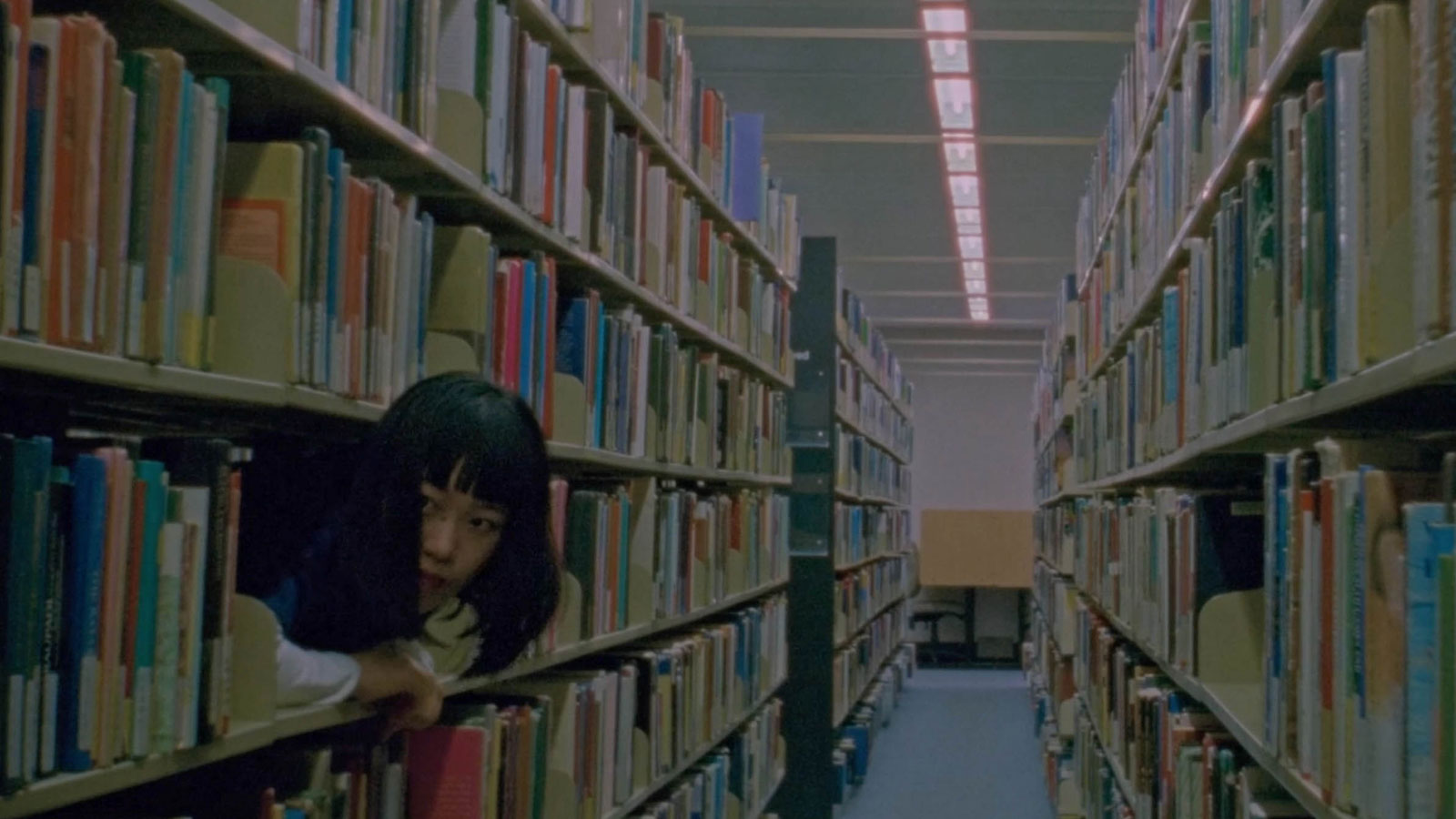Ripples of Words: Audrey Lam on Us and the Night

Critics Campus 2024 participant Isabella Gullifer-Laurie speaks to Audrey Lam about her library-set experimental feature, a meditative journey through architectural space and pages.
“I love voices, the texture of voices. And I think voices have movement.” Voices carry Audrey Lam’s debut feature film, Us and the Night, across the aisles of a university library. Crossing paths in the nocturnal hours, two young library workers, Xiao and Umi – respectively played by artists Xiao Deng and Umi Ishihara, Lam’s friends – stroll and spin between the shelves. “Because of its name,” says Umi, “the university library was like the universe.” The pair embark on expansive and celestial imaginings within the catalogue stacks. The film is a quiet experiment, one that plunges into atmospheres and archives, pulled by currents of literary allusions and language play.
Lam worked in libraries during her adolescence; she was later employed at various branches at the University of Queensland Library in Brisbane, where Us and the Night was filmed over a period of ten years. “It’s kind of suspect,” she says of the library as a public and an institutional space. “It’s hermetic; it’s like an island unto itself, with waves of people who come and then leave.” The language of geography – the wind and the sea, seasonal shifts, landforms – persist in both Lam’s turn of phrase and her visual idiom. Book spines are reflected onto grey linoleum like ripples of lakewater stilled by a photographic snapshot. The inky midnight windows are laced with cobwebs, giving the appearance of star nebulae scattered in the sky.
This last visual was a little tongue-in-cheek, laughs Lam, who was thinking of it as “a reference to the internet, the World Wide Web”. During the years she was shooting Us and the Night, the library was changing, with books being discarded in favour of digitisation. The library takes on a metaphoric resonance: a state of mind; a repository of cultural memory; a system for clarification. As a space in transition, it offered a way of thinking about temporalities and boundaries: “I wanted Umi and Xiao to be in space, in a space, and out of space too,” Lam says, thinking of “portals and porousness”.
Early on, a tropical storm builds outside, lilac clouds visible through windows, the library swimming in an atmosphere of humidity and electric crackle. “Seeping and leaking” into the scenes, Lam says, is an overlay of environmental sounds: the fall of rain; a splash of water; the crunch of gravel underfoot; the tumble of rockfall. This recorded sonic ephemera is like an entry point into “a fantasy world”, corresponding with images taken from books grafted into the visual sequence, as Umi narrates associative ideas about her dreams, reading and islands. Volcanoes, cities, coral reefs provide a visual intertextuality. As she moves through the aisles – or “isles” – Umi rummages, collecting words and themes, guided by some kind of searching desire. She has a gentle taste for homophones and puns, the secret bondage between words and phrases.

Us and the Night
Literary allusions abound, with Lam being a reader of Italo Calvino, Jorge Luis Borges, Georges Perec. She mentions the titles of Elizabeth Bishop’s poetry collections: Words in Air, Winds of Change, Walking Between Worlds, She Who Brings the Rain, When a Window Opens. Bishop’s titular poem from Questions of Travel pours out lines that read like a blueprint for the film: “the pressure of so many clouds on the mountaintops / makes them spill over the sides in soft slow-motion”. Lam is interested in the “asynchronous and slippery” qualities of language. “Reading and talking are not the same thing. I like to think about why,” she says. Rather than diegetic speech acts, much of the dialogue in Us and the Night is voiceover, lending the narration a tenor of intimately guarded address – like a private letter, or note.
As Umi and Xiao wind their way through the library, the camera lingers tenderly on its industrial furnishings. Laminated wooden desks tessellate; fluorescent beams shine at odd angles overhead; and the metal shelves demonstrate a pleasing symmetry with their crossbeams and bookends. Colours yield a gloomy radiance through Lam’s use of 16mm film. Tiles take the soft tone of waxy mushrooms; swivel chairs glow a fudgy red. Lam filmed many scenes between the periodical shelves “because of the blocks of colour”: there, books and magazines are encased in boxes and sleeves of luminous midnight blue, butter yellow and gumleaf green.
This is not the limpid enquiry of an essayist, dropping an anchor to map and chart a maritime ecology. Lam’s film captures something far more mercurial. She is interested in “the sense of movement, also the rhythm, cadence, and ebbs and flows.” This is something of a compositional system, with the words and images moving along with the temporal overlay that quickens and slows. The companionable relationship between Umi and Xiao shares this feeling or drift, the gravitational pull between the tide and the moon.
Like an open hand trailing through water, disturbing the surface, raking subterranean matter. “I wanted it to be like this ripple,” Lam says. “There are words and phrases I had in mind that aren’t in the film, but they’re so evocative. To be cast adrift, to be ships passing in the night … what does that feel like?”